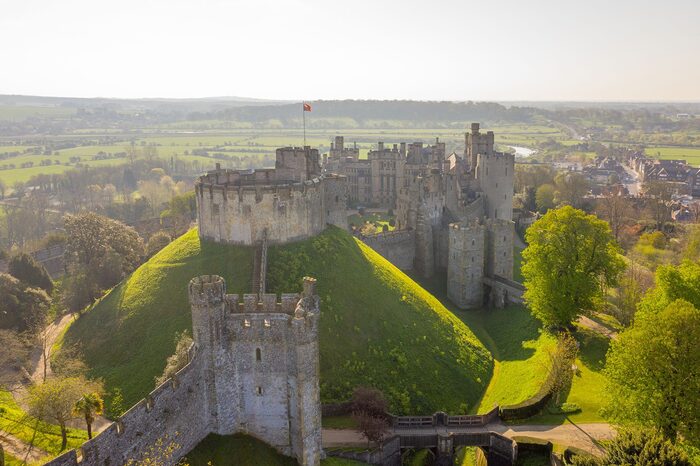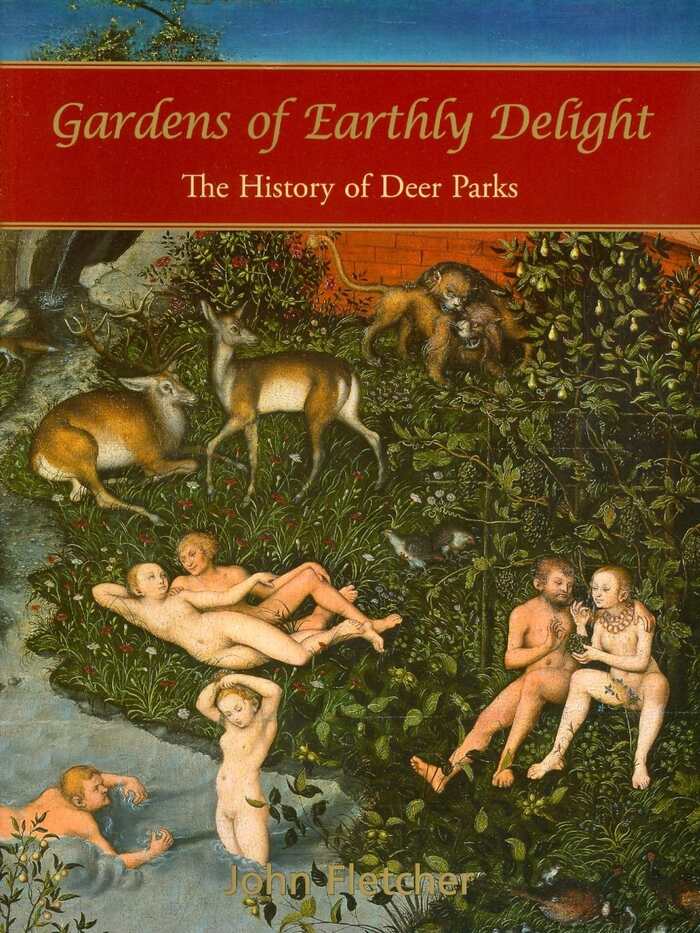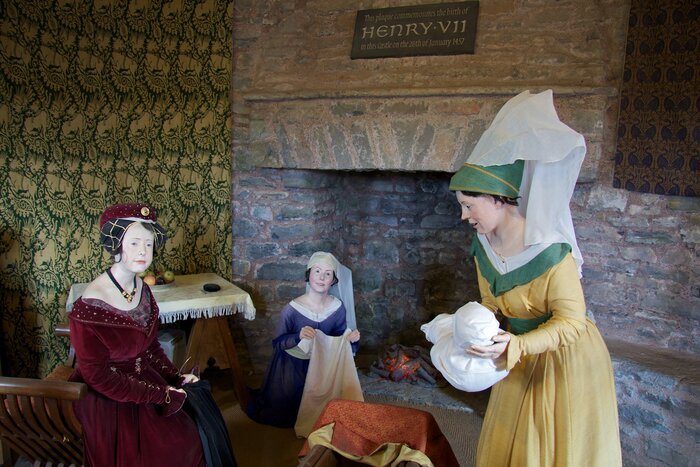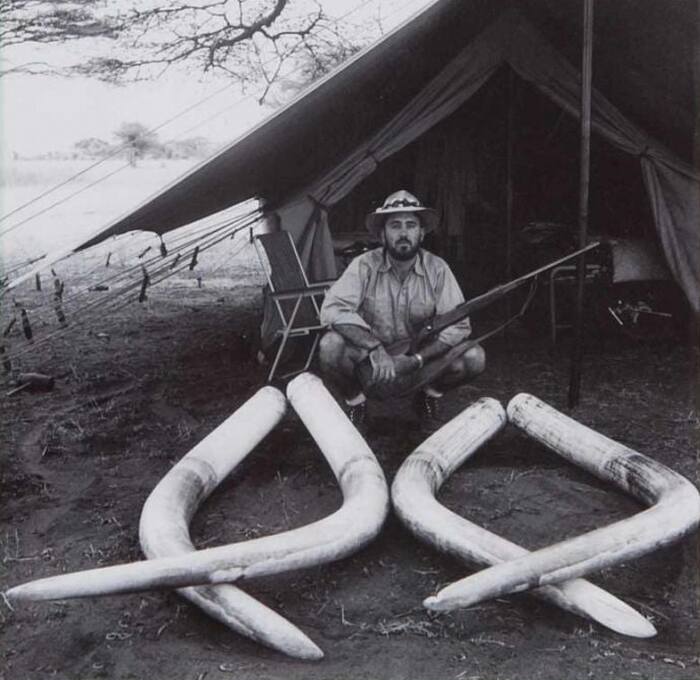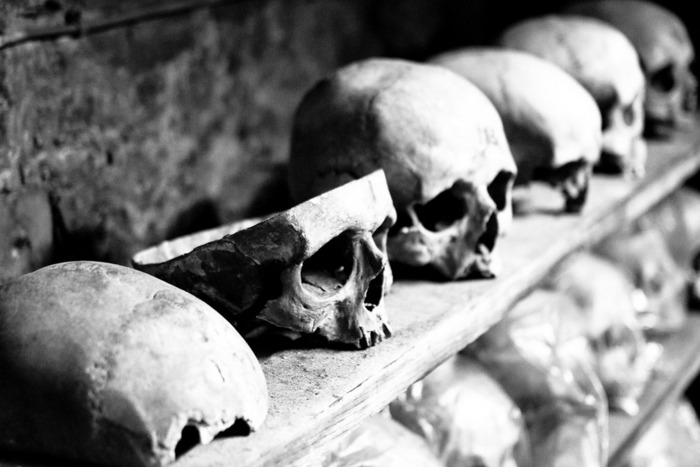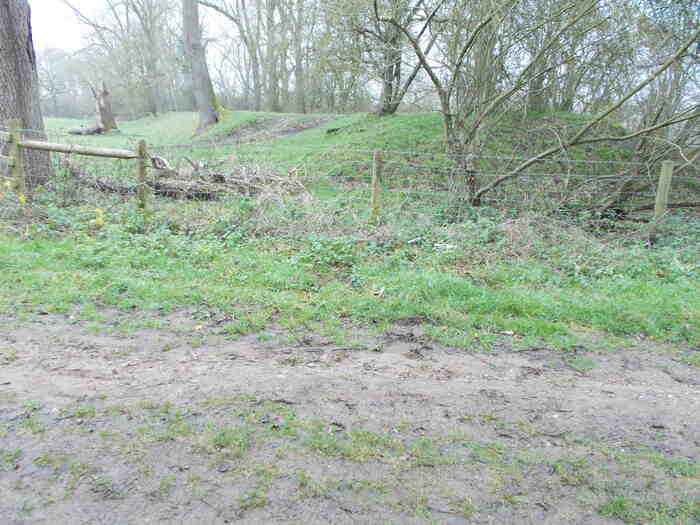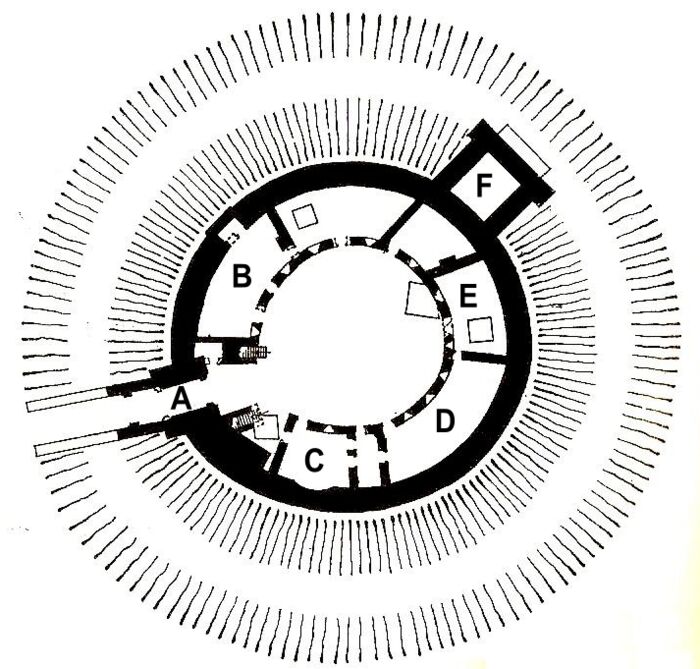Nuada's carcass processing facilities were revamped in the mid-19th Century. Thu 07 December 2023
The gigantic fingerprint of Nuada, the Wild Hunt's corpse collector. Source: Castle history - Arundel Castle & Gardens
Buried beneath Collyweston's bizarre 'lost Palace' narrative lie clues to how the Palace lost its plot, why it lost it, who helped it lose it. And when.
They are most obvious in the bizarre narrative of Collyweston's most prominent owner. Lady Margaret Beaufort: mother of Henry VII, grandmother of brother-princes Arthur and Henry.
That's Arthur as in dead and forgotten. And Henry as in dead but well remembered as England's most bedchamber-challenged hunter-king.
Analysed carefully, Lady Margaret's biography appears to be allegory hiding a truthful core. A core just discernible beneath layers of fabrication and metaphor. To unravel it, start with orthodox history's retelling of Lady Margaret's family dynamics:
From 10. Lady Margaret Beaufort and Torrington Manor - One Great Torrington:
A special royal position of ‘Kings Mother’ was created at court and Henry consulted her on many topics. The Spanish envoy Pedro d Ayala in 1498 wrote ‘ [Henry] was much influenced by his mother’.
That's Lady Margaret's son, Henry VII.
And from WHO LIVED AT THE PALACE - Collyweston Historic:
the King's second son Henry (VIII) spent many hours in the care of his grandmother.
Both he and his grandmother shared a love of hunting.
That's Lady Margaret's grandson, Henry VIII. England's hexed groom.
It was Lady Margaret, then, who showed the two Henrys how things get done.
For her own part, we're told, Lady Margaret left home early and learned in the School of Hard Knocks. Mainly learning how to make money in the property market. So much so that when Stukeley claimed Harry VII's mother was a 'Countess', he really meant it:
From The Palace of Collyweston:
Sandra: [Margaret Beaufort] also had a Counting House. So, apart from her jewels, she clearly had lots of money! You see, Margaret Beaufort administered the Midlands from Collyweston. This meant that there was also a council chamber where she could conduct business – quite unusual for a woman!
Sarah: So, Margaret actually administered the whole of the area in the Midlands on behalf of her son Henry VII?
Sandra: She did, yes. She was one of the very few women who could conduct business in her own right – [known as a ‘femme sole‘] 1. She, therefore, administered her estate independently. Very few women in the Middle Ages were allowed to do that. I think Alice Chaucer was another one. So, she had power, and on behalf of her son, she could intervene where there were disputes. People would probably come over from Coventry or somewhere similar to Collyweston for her to adjudicate on whatever was under question – and she would decide guilt or innocence – and the sentence.
It's probably news to many that Geoffrey's wife Alice Chaucer was a business woman. But was she - like Lady Margaret - into hunting?
The answer's probably in the name. 'Chaucer' resembles French 'chasseur'. In English: 'hunter'.
If you investigate England's fen-edge castles and mounds, you find a surprising number were lodges in hunting parks 2 3 4 run by lone royal women. In addition to Alice and Margaret, common names are Isabel and Elizabeth 5.
But we were talking about money.
From The Palace of Collyweston:
Sarah: It’s fascinating that Collyweston had its council chamber like other grand palaces! 6
Sandra: Of course, there was also business to be done locally, in the village and the surrounding areas; she would have collected the rents because the villagers would have paid money for the rent of lands or other taxes. So, yes, Lady Margaret was very influential in the whole area – and Collyweston was one of her favourite places.
Margaret's patch of England's Midlands was the core of a distinct administrative region:
The big red one. Mercia... Source: A Super Quick History of England
From WHO LIVED AT THE PALACE - Collyweston Historic:
By the early C16 the Manor had become the favourite home of Lady Margaret and it is well recorded that she spent more time at Collyweston than at any of her other residencies, and she had quite a few!
She did indeed. In Mercia and beyond.
From Lady Margaret Beaufort:
In 1467 she apparently stayed at Woking from the end of March until the 24th August, then embarking on an epic expedition around her West Country estates. From Basingstoke she went to Andover, Salisbury, Shaftesbury, Yeovil, Wells, Bristol and Chepstow to Wreyland in Devon, staying for almost a week before returning again via Bristol, Wells, Glastonbury, Thornbury and Sampford Peveral - arriving back in Woking in early November.
... leaving at the end of April for a quick tour of some of her properties to the north of London at Ware, Royston and Huntingdon, before returning to Woking
That's a lot of residencies. Especially for a woman who had - orthodox history also alleges - lost her properties to rival royals six years earlier. Before we get to that, let's remind ourselves about Royston.
Enigmatic in its own right, Royston was the food and fashion centre James I developed in the centre of an enormous hunting park.
James went on to commission the even bigger hunting park now called Rockingham Forest. Its true size isn't public but it covered a large chunk of Mercia. Most importantly for Lady Margaret, the park's north-eastern corner butted up against the grounds of Collyweston Palace:
Ermine Street ran between two enormous hunting parks
Key:
- Blue line: Ermine Street between Castor and Stamford
- Blue marker: Site of Collyweston Palace
- Red marker: Royston and Rothwell as appproximate hunting park centres
- Red Circles: Approx extent of Royston and Rockingham Forest hunting parks
Apparently, James I didn't much use the well-engineered road between his hunting parks.
From Collyweston House - Royal Palaces:
Despite James I love of hunting in Northamptonshire he seems not to have made use of Collyweston and on his death it was granted away to one of his grooms of the bedchamber.
Grooms of the bedchamber?
Unless you were bred to please guests in a hunting park, you may need reminding of the business case that links hunting parks and bed-chambers with 'Devil', 'Grim' and 'Groom'.
Academia can be a bit coy about this:
Though not that coy. Source: Gardens of Earthly Delight: The History of Deer Parks
Westworld, in contrast, gets down to business:
And more clearly reflects hunting park realities. Source: Westworld
The royal bedchamber featured in another significant Beaufort home: Pembroke Castle in south Wales. There, in 1457 - a year into the first of a series of apparently profitable marriages - we're told a 13-year-old Lady Margaret squeezed out an enormous neonate:
Birth of the Tudors. Source: Pembroke Castle - Wikipedia
Margaret is the understandably pallid lady on the left.
Certain aspects of Harry's birth are not well explained by Pembroke Castle's diorama. Lady Margaret's quick re-dressing and perfect coiffure are two of them. Her composure so soon after a birth that apparently tore her from nape to nose is a third.
The midwife's ignorance of how to properly hold a human neonate is a fourth. Although that may be explained by her horns. Perhaps she trained in an off-world nursery.
Despite these thought-provoking details, Pembroke Castle's depiction does remind us that Harry's was a miracle birth.
From Lady Margaret Beaufort - Wikipedia:
Margaret's confessor, John Fisher, deemed it a miracle that a baby could be born "of so little a personage".
Modern, educated humans actually believe this tosh. But in 1889, no one did.
Back then, the Rev. WD Sweeting - Second Master of Peterborough Cathedral School - presented evidence that a year after Harry VII's birth, the teenage Lady Margaret was still living at home with her mother. In the village of Maxey. On the other side of Stamford, not quite 10 miles east of Collyweston.
From The Sweeting Lecture on the history of Maxey, Rev. WD Sweeting, 1889:
It is quite likely too that for some time at least, in her childhood, if not in later years, she was an inhabitant [of Maxey] and lived in the old castle. I will tell you why I think so. In a curious old manuscript book, The Red Book of Thorney, belonging to the Earl of Westmorland, is copied an old petition from John Bukke prior of Deeping. “ to the High and gracious Princesse the Duchesse of Somerset”, who was the mother of the Lady Margaret.
This order was given at the Castle of Maxey, 1455. This seems to show that the Duchess occasionally lived here. She only had one child, the Lady Margaret, who was at that time 14, and it is unlikely that she would be away from her mother.
Decide for yourself whether or not the High and gracious Princesse the Duchesse of Somerset knew in 1455 that her 14-year-old daughter would be married a year later, widowed, then rendered infertile by the birth of her enormous son.
And still only be 13.
Time travel may be possible but it is more likely that Harry VII's difficult birth and his tiny, sterile, teenage, widow-mother were added to English history some time after Sweeting's 1889 lecture. Perhaps by the same writers who helped romanticise England's real past into today's more palatable history.
Because, yes, the conspiracy-minded may have noticed certain parallels between John Fisher's account of Lady Margaret's miracle birth and John the Fisherman's account of another miracle birth.
They may also have noticed - along with even the most orthodox minds - that as well as coming a close second to the Virgin Mary in the miraculous birth department, Lady Margaret also worked as hard as the Good Lady at spreading Christian doctrine.
From The Sweeting Lecture on the history of Maxey:
She was greatly interested in learning and education; she founded two famous colleges at Cambridge, Christ’s and St John’s, which remain to this day enjoying the fruits of her liberality; she founded also a professorship, still called the Lady Margaret Professorship of Divinity.
For the fact-checkers, that's actually two 'Professorships of Divinity': one at Cambridge and one at Oxford. Though none at Stamford 7.
It seems Lady Margaret was the physical source of Britain's royal family, a sponsor of Christianity and - for those who know 'Mary' and 'Margaret' are variations of the same name - a role model for the New Testament's Virgin Mary.
And also for the Old Testament's:
From Mary in the Old Testament - Mother of All Peoples:
The fact that she is clearly designated as a woman without a husband, something most unusual... represents an implicit reference to that same virgin birth.
These divine coincidences disappear if you know who helped write both testaments. And when.
Presumably forced to mother the enormous Harry VII while travelling between various manors and hunting lodges, teenage Lady Margaret's challenges had only just begun.
Allegedly, when Harry was just four years old, Yorkist Edward IV won a momentary victory in the Wars of the Roses. As a result, the Yorkists confiscated Lady Margaret's properties.
At this point - 1461 actually - Collyweston's narrative asks you to believe another inconceivable miracle.
It asks you to believe Beaufort's Collyweston palace complex was not identified, discussed, and documented by Edward IV's relatives and courtiers as they divvied up Lady Margaret's properties.
And this is part of a wider problem with the narrative's grip on Lady Margaret's assets. In addition to claiming she acquired hunting parks, properties and palaces indirectly from James I and from various husbands, history claims she lost the lot.
Then, it claims, she acquired a new array of manors. These fell into her by then barren lap some time after 1485 when Harry beat the Yorkists at the Battle of Bosworth. That's just north west of Rockingham Forest hunting park. And may well have been in it, given that the park's northern boundaries are not entirely known, let alone agreed.
From 10. Lady Margaret Beaufort and Torrington Manor - One Great Torrington:
Shortly after his coronation Henry granted his beloved mother many manors and holdings making her one of the richest people in England.
Not at issue here is which manors and hunting lodges Lady Margaret owned when, which she lost when, which she re-acquired when, or which she acquired for the first time when. Although it should be. What is at issue is that against this history of royal property confiscations and royal property returns, we're to believe all documentation about the location of the fabulous Collyweston Palace went missing.
So let's not believe. Instead, let's look at what else is missing from Lady Margaret's biography.
Left scratching for income after Edward IV's earlier (1461) Yorkist victory, our courageous femme sole had only two options. Sensibly, she took both of them. The first was to get either herself or a suitable family member back on the throne.
In Blood Sisters: The Women Behind the Wars of the Roses (New York, 2013), author Sarah Gristwood popularises evidence for one orthodox view: that Lady Margaret conspired to get Harry - that's Henry VII - on to the throne.
According to Gristwood, this theory required Lady Margaret's part in a double-infanticide.
From Lady Margaret Beaufort - Wikipedia:
Lady Margaret is known to have conspired with Elizabeth Woodville, mother of the two York princes whom Richard confined to the Tower of London, after rumours spread of the boys' murder.
Gristwood, however, suggests that another was responsible; Henry Tudor's path to the throne was certainly expedited by their disappearance, perhaps motive enough for his mother – his "highly able and totally committed representative" – to give the order.
To clarify Gristwood's cautious wording: she is saying a suspicion held by some orthodox historians is that Lady Margaret conspired with Elizabeth to blame Richard II for a succession-preventing infanticide for which she herself was actually responsible. Lady Margaret, that is, not Sarah Gristwood.
Already being aware of John Fisher's 'Miraculous Birth' narrative, you may be sensing more narratives shuffling into line here. Shuffling into another parallel line actually. The parallel is with the story of King Arthur and his son Mordred. Mordred was the product of a (hopefully) accidental mating between Arthur and his half-sister Morgeuse. As a result, Mordred became a succession threat to Arthur's throne. And as a result of that, myth claims, Arthur ordered all male infants be killed to prevent Mordred's succession.
Do you need me to point out how succession threats, fertility problems and infanticides involving Arthurs, Henrys and Lady Margaret seem to lie in parallel? As if lying in bed next to the virgin Mary and the thronally insecure King Herod?
Somehow, infanticide keeps pushing its baby-sized scythe into birth-of-the-Tudor-dynasty narratives. It's as if infanticide were a dead horror-baby intent on hacking its way out of the secret womb of Tudor history.
Expect, therefore, to be deeply discomforted by the evidence that follows.
Beaufort's second option was to extract more cash from her tenants. Of course, for that to work, her tenants had to have cash to extract. Given the wealth once evident at Collyweston Palace, one presumes they did.
However, the area Beaufort administered from Collyweston was largely covered by Rockingham Forest hunting park. Parts of which - we're told - were off-limits to locals; while much of the rest was - we're told - unavailable for conventional farming because it was covered by royal trees.
And - we're told - by bow-toting bandits.
This left Lady Margaret with a problem England's elites have yet to solve. How much tax can you realistically raise from subsistence-level incomes in an economy run by the elite for the elite?
One possibility is that Lady Margaret did solve that problem.
Her solution may be the real reason Wild Hunt folklore speaks so paradoxically of hunts for both female demons and innocent women.
And her solution may be the real reason Collyweston Palace had to be 'lost':
Athena: another name for Diana the Huntress. Source: The Hunt
Did England's best reputation management team 'lose' Collyweston Palace in the hope Lady Margaret's 'thing' didn't go mainstream?
This is an extraordinary claim.
And extraordinary claims require extraordinary evidence.
Extraordinary evidence that might - had it not been tidied away - have looked like this:
Sedlec still welcomes your business. Source: The Dark Old-World
The narrator has a point:
This hunter has four points. Source: Sport Hunter in Africa
And a photo to prove it.
Because hunters don't just love trophies. They love to be photographed with trophies:
He wants his photo. And hers. Source: Westworld
Shockingly, there is evidence Rockingham Forest had skin in the photography game. This via the work of an inventor living near its western edge shortly before the reputation management team moved in. But we'll expose that in good time.
Before that, if we're to even notice extraordinary evidence of reputation management when we encounter it, we need to appreciate what extraordinary evidence looks like. And to do that we need to know the role hunting parks played in developing the toys we foist on our kids.
Unfortunately, hunting parks produce so many trophies - decomposing, smelly trophies - that most of them have to be quickly converted into marketable value-adds. Into food for banquets. Into leather. Into souvenirs. And into games to amuse hunting park guests after dark.
Board games that require chips, counters and dice:
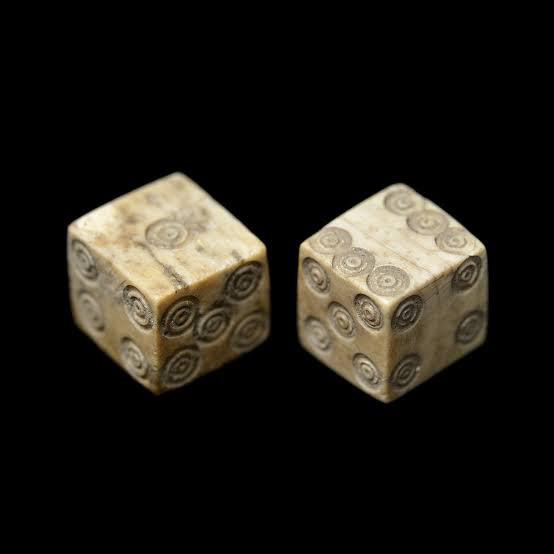
Dem bones were made for rolling. Source: Ancient Roman dice made from bone
Pretty much every movable part of classic board games was originally made from surplus bone.
And - shooting from the hip as it were - that's not all.
Hunting parties - and many other human parties - still like to to play board games amid the decorations traditionally associated with celebrating achievements:
Especially if it's your bladder. Source: BALLOONS | How It's Made
Of course, Sedlec Ossuary isn't in Collyweston or Stamford. It's in Kutná Hora in the Czech Republic. And while it's curious that Kutná Hora is twinned with Stamford, that doesn't make Sedlec extraordinary evidence of human-hunting around Stamford or Collyweston.
It just makes Sedlec extraordinary evidence of human-hunting around Kutná Hora.
For extraordinary evidence of human hunting around Stamford and Collyweston, you need to stalk the dark heart of Rockingham Forest itself. Starting at the much transformed ossuary beneath Holy Trinity church in the village of Rothwell:
They grew their own soup-bowls. Source: Rothwell bone crypt - Flickr
Actually, that skull was probably cut for archaeological forensics. Though the image highlights a social legacy that still dominates English economic thought: the neo-liberal aversion to the risks and costs of manufacturing products the hard way.
Or, as fans of England's other Lady Margaret might say: why pay people to make pottery when it's cheaper to make pottery out of people?
The weak shall become the earthenware. Source: The Giant Humans That Hunted & Cannibalized Neanderthals
We don't know if Holy Trinity's 1,500 current inhabitants were once arranged like Sedlec's 40,000 to 70,000 inhabitants. That is: as residents-turned-decor.
But various clues suggest Holy Trinity's ossuary wasn't exactly built for private expressions of grief:
After preying on them. Source: The Rothwell Charnel Chapel project: The Digital Ossuary
Understandably, modern historians are reluctant to support the suggestion Holy Trinity was once a well-lit showroom decorated with trophies hunted in Rockingham Forest. But even the most fact-fearing historians agree that in English 'pray' is pronounced the same way as 'prey'.
And historians do admit Holy Trinity church's history has peculiarities. It was much larger until 1673, 8 when it was downsized, then more or less abandoned. This change in fortunes followed a lightning strike and one of those earthquakes to which England's Midlands seem so enigmatically prone 9.
Holy Trinity's ossuary isn't merely evidence - and perhaps even extraordinary evidence - of human hunting in Rockingham Forest. Its narrative is also evidence - and is perhaps even extraordinary evidence - that the best reputation management teams were as "all over it" in Rockingham Forest as they were in Collyweston.
They were so all over it, it's even possible to name one member of the team. And to produce his photograph.
To show this, you have to appreciate a second issue with big, busy hunting parks: they require a lot of infrastructure.
Infrastructure to move staff and customers around. And carcasses.
A big, busy hunting park produces way more bladders and bone than can be processed into balloons, board games and soup bowls. At least, way more that can be processed and used on-site.
But, as the best reputation management teams know, no matter how much effort they put into hiding transport and carcass processing infrastructure, that infrastructure leaves distinctive fingerprints.
Provided you know what you're looking for.
Once you do, the remains of removed transport infrastructure are so common that they are also easy to ignore. Like this agger on the lowland route into Rockingham Forest between Stamford and Collyweston:
Agger stub below Collyweston scarp. Google Maps
If anyone does notice it, abandoned infrastructure like this is easily passed off as a flood bank, a Roman road or a quarry track.
The remains of removed buildings are also easily passed off as a medieval farmers' fields; their quarried cellars as fish ponds. Once you're familiar, these fingerprints are easily found in the fields between Collyweston and Melton Mowbray; and further into Rockingham Forest toward Rothwell and Rockingham.
But the fingerprints of purpose-built carcass dismantling facilities are much harder to find.
Primarily because modern humans have no idea they are looking for these:
It's called a dakhma. Source: Trinity of Old-World Secrets
Its condition is impressive. Although that may be because it was used for carcass dismantling until 1974.
The image shown at 23 seconds into the video is worth studying. It is explained in more detail at Towers of Silence in Yazd - History, Architecture & Visiting Guide. The final photograph shows the bone collection pit in the centre of the dakhma. Bones deposited in the pit were not destined for the nearest ossuary. They were destined for value-add processing. As we shall see.
So. Now we know what we're looking for.
We're looking for distinctive circular stone structures in former hunting parks. Wide, circular structures originally built with an internal roof that sloped down to a central circular 'court' or pit. Wide, circular structures that the best reputation management team have cleaned up.
Structures like this:
It too has been picked clean. Source: Restormel Castle - Wikipedia
'F' marks Restormel Castle's former chapel. Just where you'd need one if you accept that 'chapel' = 'chop hall'.
Today, we call these structures 'shell keeps'. But we've only called them that since about 1860. Which gives you a provisional end date for the reputation management programme.
Once you understand how Yazd's Tower of Silence functioned, it's easy to decrypt orthodox descriptions of England's shell keeps.
From Shell keep - Wikipedia:
True shell keeps were a stone wall around the upper perimeter of the motte with lean-to buildings against this outer wall and a small courtyard in the middle.
The phrase 'lean-to' hints at the all-important sloping roof. The Yazd video shows how the slope enabled drainage. The liquid shown trickling past the corpses could be used as fertiliser.
And it was.
You already know the function of the the small central courtyard. It should be noted though, that the little 'chapel' commonly attached to shell-keeps sometimes had a pit in its floor. This is further evidence that this room was used for combing and cutting. For cutting off hair, flensing skin; for cleaning and collecting re-sellable bio-material and disposing of 'spoil'.
The Infrastructure Hidden in Plain Sight:
Restormel is said to be England's best preserved shell keep. Other carcass dismantling facilities were much more thoroughly hidden. They were hidden in the most effective way possible: in plain sight as tourist attractions.
Like this one:
Centre: The Round Tower. Source: Windsor Castle - Wikipedia
Windsor's iconic Round Tower was lower and less ornate until around 1824. Then it was raised and decorated to look more imposing.
That was presumably to make it look less functional - though perhaps it was extended to help it handle larger throughput. As we saw at Narborough bone mill.
Pretty much everything to the right of The Round Tower is - historically-speaking - a recent fake.
From Windsor Castle - Wikipedia:
the Upper Ward was judged to be "to all intents and purposes a nineteenth century creation which stands as the image of what the early nineteenth-century thought a castle should be"
an image of tall towers and battlements influenced by the picturesque movement of the late 18th century.
Also fake is pretty much everything to the left of The Round Tower.
From Windsor Castle - Wikipedia:
most of the Lower Ward was renovated or reconstructed during the mid-Victorian period ... to form a "consistently Gothic composition".
In short, it seems that Windsor Castle was largely built in around 1850. Before then Windsor was a simple, circular facility.
Sited in an enormous hunting park.
Various architects are credited with designing Windsor's 'ancient' mid-19th century castle. But the architect credited with poshing up its shell keep is Anthony Salvin. His is a name worth remembering.
Strikingly similar to Windsor Castle is Arundel Castle in West Sussex:
Its central feature is Arundel Tower. Source: Arundel Castle - Wikipedia
A description of Arundel Tower - allegedly surviving from 1635 - suggests the key features of a dakhma had by then been removed and the structure repurposed for horticulture. I doubt the date but I don't doubt Arundel Tower produced compost to die for.
From Arundel Castle - The creation of one of England's great princely seats:
The building was roofless and a garden was laid out within the circuit of its wall. It overlooked an orchard with ‘fruitful appletrees, peartrees, plumtrees and filberd trees’, as well as a ‘large sweet garden… within the walls'
And yes, Arundel Tower towered over a complex of hunting parks.
Between 1854 and 1865, Anthony Salvin was paid £250,000 19th century pounds to oversee one of England's most extraordinary dakhma conversions.
He converted Alnwick Castle's 'shell keep' into a cluster of ten 'ancient' towers.
Salvin's picturesque towers still dominate the centre of Alnwick Castle:
Children know them as Hogwarts. Source: Alnwick Castle in Alnwick, Northumberland
If you didn't know, you wouldn't know. But why would you? After all, England's best reputation management teams have been all over it.
And Salvin certainly was all over it. He is credited with reconstructing a formidable list of towers, castles and fortified 'country houses'. To help you appreciate just how recently he salvaged the reputation of England's carcass processing facilities, Salvin lived 40 years into the age of modern photography:
Anthony Salvin. 1799-1881 10. Source: Anthony Salvin - Wikipedia
Tantalisingly, photographs of the original structures Salvin worked on apparently did not 11.
Appreciating that shell-keeps are reputationally-managed dakhmas helps explains why they mystify the few historians that care to study them. In his 2016 paper Shell-keeps revisited: the bailey on the motte?, Robert Higham notes (on page two) that academics have not studied shell keeps much since GT Clark 'promoted' them as a type of medieval castle. Which Clark did late in the 19th century.
Their function is not as well understood as it should be, Higham continued, because they haven't been catalogued properly either. He drew attention to several single-wall shell-keeps that seemed, originally, to have had two walls - one within the other.
Double walls are no mystery to the builders and staff of dakhmas.
Higham also drew attention to the mysterious lobes that bulge outward from some shell keeps. They "should be seen as a separate form", he said.
Indeed.
Lobes are also no mystery to builders and staff of dakhmasNor to people boning up on carcass processing facilities:
Mumbai dakhma, India. Source: Gazetteer of the Bombay Presidency, Bombay, 1896via Old World Dome of Doom
You may need to pause the video to read the labels on the lobe towers.
Why would some dakhmas consume a lot of water?
A whitewash by any other name. Source: Westworld
One other name being 'ritual cleansing'.
It's hard to believe we've been led up the garden path about England's carcass processing facilities. Even though the reputation management team apparently converted two facilities into exactly that: garden paths.
This is Belhus Park in Essex:
The secret garden of concentric circles. Source: Tudor to Tartaria (Video no longer available)
This next garden path is in the middle of Rockingham Forest about eight miles north east of Rothwell. It's roughly halfway between Rothwell and Collyweston.
Take a look:
A rose garden by any other name. Source: Rockingham Castle - Flickr
From Rockingham Castle - Discover Rutland:
The layout of [the] gardens dates from the 17th century, following the restoration of the Castle gardens after the English Civil Wars. Emulating the Norman keep, the circular Rose Garden was laid by Sir Anthony Salvin in the mid-nineteenth century
Visible on the viewer's left in the above image are the tops of the two fat 'D' towers that form Rockingham Castle's gatehouse:
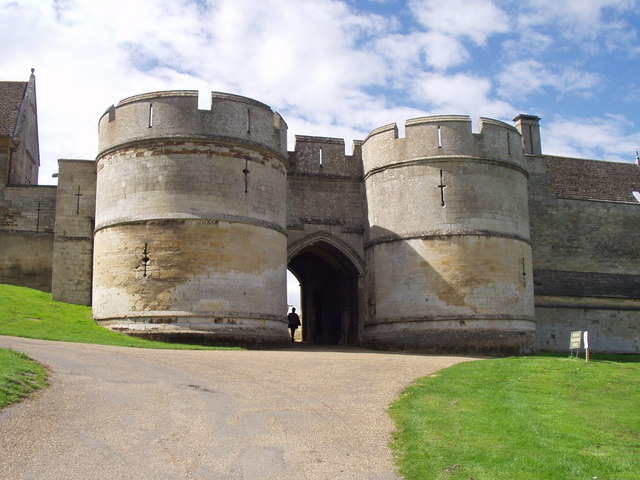
Fat, famous, and in the wrong place. Source: Rockingham Castle - Wikipedia
Rockingham's twin 'D' towers are hard to explain. As the photograph attempts to show, they face into a field rather than down the approach road. And their defensive function is compromised by their internal layout and the smaller walls around the rest of the castle.
But Rockingham's 'D' towers successfully conjure another vision. A vision of a 19th century architect ordering an enormous pile of surplus curved stone to be rebuilt as a couple of picturesque gatehouse towers.
If that sounds like, well, just a vision, heritage surveyors have also wondered if Rockingham Castle's records hint at a missing shell-keep.
From Shell-keeps revisited: the bailey on the motte?, Robert Higham, 2016, p12:
In some other cases, where no fabric now survives, the editors speculated from the terminology employed in the records that the documented works may have related to shell-keeps: as at Marlborough and Rockingham.
What We've Found So Far:
Lady Margaret Beaufort's biography appears fabricated to hide her actual role. Her role administering a network of Mercian hunting parks where humans were processed at scale.
The evidence trail reveals:
- A "lost palace" at Collyweston that was too large to overlook—unless deliberately hidden
- Hunting park infrastructure requiring carcass processing facilities
- Circular stone structures called "shell keeps" that match the design of Towers of Silence (dakhmas)—carcass dismantling facilities still used in Iran until 1974
- Holy Trinity's ossuary at Rothwell containing 1,500+ processed remains
- Bone china industries at the western edge of the park requiring massive bone supply
- A Victorian architect (Anthony Salvin, 1799-1881) systematically converting these facilities into romantic "ancient castles"
Besides leaving extraordinary evidence of mass carcass dismantling facilities disguised as ancient castles and as garden paths and well fertilised gardens, then surely if human carcasses were piling up in the English Midlands, there should also be indirect evidence. There should be evidence of large volumes of raw stock being sold on for secondary processing.
For example, if local craftsmen were producing prodigious supplies of human skin and de-fleshed bone, you'd expect to see their output reflected in the region's industries.
And indeed, it is so.
At the north western end of the rail line (and former canal routes) between Stamford and the West Midlands is The Potteries.
It's famous for bone china:
Note that last name. Source: There Is Actual Bone In Bone China
That's the same Wedgwood family whose bone-based pottery wealth funded Darwin's claim that humans are the natural offspring of mutant chimps. And whose interests - also per that link - included weaponry, game management and eugenics.
Wedgwood's still occasionally functional bone mill can be seen at Etruria Industrial Museum. It was at Etruria that Thomas Wedgwood made a key contribution both to photography and to the trail of clues about the use of human body parts at the western edge of Rockingham Forest.
From Thomas Wedgwood (photographer) - Wikipedia:
Thomas Wedgwood (14 May 1771 – 10 July 1805) ... is the first person known to have thought of creating permanent pictures by capturing camera images on material coated with a light-sensitive chemical.
his conceptual breakthrough and partial success have led some historians to call him "the first photographer".
Historians of photography probably turn pale when asked which 'material coated with a light-sensitive chemical' photographers like Wedgwood were experimenting with.
Though they do admit it was leather.
From Photographic Film History - Who Invented Photographic Film:
Early tries at photography didn’t use film but silver-plated copper sheets, paper, and even leather covered with light-sensitive chemicals.
A few clues survive about the kind of leather Wedgwood may have used. He communicated some details to fellow members - self-styled 'lunaticks' - of Birmingham's Lunar Society:
The white kind of leather. Source: (Video no longer available)
From France comes more evidence that early photographers used human skin as a photographic medium.
From Daguerreotype - Wikipedia:
To guard against letting any secrets out before the invention had been improved, [Louis Daguerre] and [Nicéphore Niépce] used a numerical code for security. 15, for example, signified the tanning action of the sun on human skin (action solaire sur les corps)
Daguerre and Niépce were a bit more explicit than that. Their code used the number 83 to mean 'skin pad'. 13
You will have to decide for yourself whether this is evidence - extraordinary or otherwise - of a market for surplus body parts at the western edge of Rockingham Forest 14. Just be aware that Away in a Manger - Part Five presents acknowledged evidence that human skin was being used for books at the same time Wedgwood and colleagues were experimenting with 'white leather'.
But that's just the West Midlands. And France. Is there extraordinary evidence - or even any evidence - that human bones were processed within or east of Rockingham Forest?
From Lace maker's bobbins:
Until the mid-nineteenth century, the craft of lace making provided occupation for thousands of women in the East Midlands (Bedfordshire, Hertfordshire, Northamptonshire and the borders of Berkshire and Oxfordshire), as well as in Devon, Somerset and Wiltshire.
'Until the mid-nineteenth century', they say... Again, see Away in a Manger - Part Five for more evidence this period marks the end of carcass commerce.
From Bobbin lace - Wikipedia:
Bobbin lace is also known as ... bone lace, because early bobbins were made of bone or ivory.
The mid-19th century decline of bone-lace seems to correlate with a bone shortage after dakhmas were converted into 'ancient' shell keeps. Not to mention rose gardens and orchards.
In response, lace makers shifted from bone bobbins to wood:
Wooden bobbins look similar but weigh more. Source: Bobbin lace - Wikipedia
Yet bone supplies didn't die away entirely.
From Lace maker's bobbins:
Another bobbin from the collection with a personal touch is made out of bone and has the name 'Hannah' inscribed around the base. The name was drilled into the shaft of the bobbin by the maker and then coloured in with red ink.
Here's Hannah:
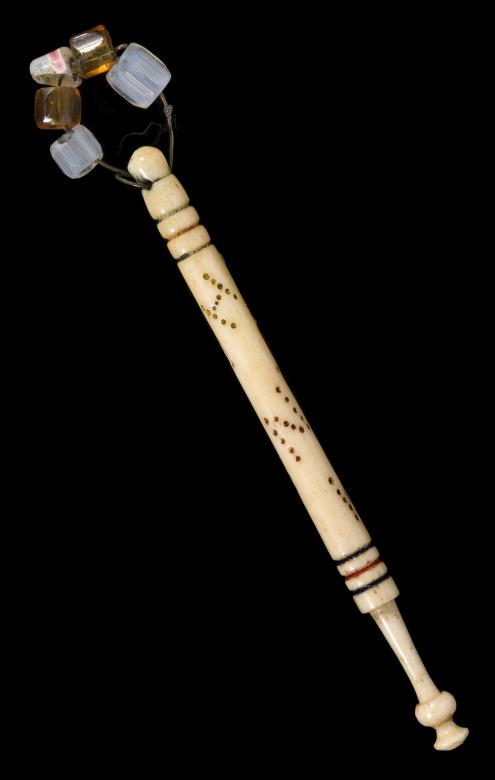
Or what's left of her. Source: Lace maker's bobbins
It seems human bone became rarer in England's east Midlands but was still valued when donated by a relative or sold by the justice system as a souvenir.
From Lace maker's bobbins:
Bone was a popular material for inscribed bobbins ... Bobbins inscribed with names, like Mrs. Butler's, were extremely common.
A bobbin maker would probably have had a stock of 'standard' expressions of affection ('Forget me not'),
The commercial nature of bobbin making, however, is probably best illustrated by the phenomena of the 'hanging bobbin': bobbins that were made to commemorate the public hangings and proved extremely popular souvenirs. They were inscribed with the name of the criminal and the year of their execution ('Joseph Castle hung 1860').
Obviously, correct labelling of carcass parts was important around the Rockingham Forest of old. Apparently, more so than correct labelling of some of the forest's former structures.
Souvenirs - or perhaps carcass processing tools - may also explain a strange discovery made near Crowland in 2021. There, archaeologists excavated a low rise in Anchor Church field - the remains, they said, of:
a henge of truly monumental proportions.
They found two bone combs:
And dated them to AD 500 - AD 900. Source: Archaeologists Discover a Hidden Ancient Henge in England
Plenty of evidence suggests what Crowland's henge of truly monumental proportions might really have been. And when its staff might have stopped using bone combs to process 'stock'.
And I'm not suggesting the combs are bits of Crowland's most famous and much-tampered-with carcass: St Guthlac. I am suggesting the combs didn't spend 1,100+ years buried in one of the wettest parts of England. Because if they were that old, both were well past their 'Rot By:' date when they were found.
At the south eastern edge of Rockingham Forest, we find the centre of England's shoe and bootmaking industry. That was primarily based around Rushden and Higham Ferrers, which had good rail links to the lines crossing Rockingham Forest.
A couple more pieces of extraordinary indirect evidence suggest Rockingham Forest once hosted an unusual concentration of violence and that concomitant of violence: carcass management skills.
First, shortly before Rothwell's unnatural-sounding 17th century natural disasters, rent collection in the village required courage and armed guards.
From Rothwell Charnel Chapel - History of Rothwell:
the most recent charter (James I Charter of 1614) is read by the bailiff on his horse, the national anthem is struck up by the town band and then youngsters aged between 16 and 24 try and wrestle staves held by the halberdiers - in this way the “rumble” begins.
It is believed that originally the halberdiers/stave bearers were given specially marked staves at the start to guard the bailiff while he collected the rents. They were only paid at the end of proceedings after producing their stave and it wasn’t always the same person who was given the stave and who ended up handing it in to collect payment!
Second, in 2021, meat processing businesses around Melton Mowbray were granted Protected Geographical Indication (PGI) status for Melton Pork Pies. The label officially recognises and protects rights to profit from the extraordinary - unique even - butchery skills located between Rockingham and Collyweston.
In the best Rockingham Forest tradition, meat processors started fighting. Melton's pork pie producers claimed extraordinary carcass processing was a Melton Mowbray skill, not a regional skill. They said butchers south of the town - meaning Rockingham Forest - had no right to use Melton's PGI label.
The carcass strippers of Rothwell - and perhaps also Rockingham - must have been rolling on their dakhmas.
To trim the fat from a long story, in March 2025 the UK government ruled Melton's unique butchery skills had previously extended beyond Melton. Therefore, it ruled, meat processors as far south as Northampton were also entitled to slap Melton's PGI label on their products 15.
Melton's PGI dispute reminds us that merely sticking a label on something - or on somebody - doesn't turn the something - or the somebody - into what the label claims it is.
Dusting the Narrative
We dusted a large English hunting park for fingerprints of human hunting and found evidence of a former carcass dismantling facility. We also saw evidence of carcass dismantling facilities in other hunting parks. We saw evidence these facilities were repurposed in the mid-19th century.
We saw narratives changed or fabricated - seemingly to hide human hunting, to hide the removal of transport infrastructure and to downplay the scope of secondary human carcass processing across the English Midlands.
And yet with a clean-up project as big as this, we should be able to dust the narrative itself. We should be able to see smears left by historians as they wiped their fingerprints off various revisions of England's hunting park narrative.
And we can.
We see three of them at the orange markers on this map of the hunter queens and hunter goddesses between Royston and Rockingham Forest hunting parks:
The hunting honeys of Ermine Street
Key:
- Blue line: Ermine Street
- Orange marker: St Tibba/St Eabba/Diana the Huntress
- Blue marker: Hunter queen Margaret Beaufort's properties at Collyweston and Maxey
- Violet marker: Wild Hunt leader Saint Cyniburga/Kyneburga/Lady Ketilworth/Lady Hackelberg at Castor
- Red circles: Rockingham Forest and Royston hunting parks
The two orange markers at Ryhall - a posh village immediately north of Stamford - mark the homes of two new hunter saints.
From The family memoirs of the Rev. William Stukeley, M.D., William Stukeley, published 1882, in an entry allegedly dated 26 June 1736, p170:
Tibba and Eabba, of the royal Mercian blood, owned Ryhal. They were at first wild hunting girls, at last saints.
We see two girls revised much like their near neighbour - teenage-mom and huntress-queen Lady Margaret Beaufort.
Like Lady Margaret, Saint Tibba's revisions were to give her a divine destiny.
From The family memoirs of the Rev. William Stukeley, M.D., William Stukeley, published 1882, in an entry allegedly dated 26 June 1736, p167:
"'Tis now above 700 years since St. Tibba, the celebrated saint of Ryhall was taken out of her grave there and carryed to Peterborough Church by Abbot Elfin. The inhabitants there have still an obscure memorial of her, but have lost her name. They call her Queen, and say she used to walk up to Tibbal's hill, and wash her in a spring there. This is all they know of her."
Remembering here that according to Midlands historian Bob Trubshaw, 'Queen' originally meant 'prostitute'.
Astute readers will have noticed how Rev. Stukeley's account of St. Tibba very strongly resembles Rev. Stukeley's account of Saint Kyniburga AKA Lady Conyburrow AKA Lady Ketilborough AKA wild hunt leader Lady Hackelberg at Castor some 12 miles down Ermine Street.
As memories circulated of Rutland's famously pure spring water glistening and shimmering on Tibba's lithe, huntress body, the revisions that elevated her to divinity become more crudely obvious.
From Magna Britannia antiqua & nova or, a new, exact, and comprehensive survey of the ancient and present state of Great-Britain, Vol 4, Cox, Thomas, Anthony Hall, Robert Morden, 1738, p564:
One Tibba, a Saint of the lesser Rank, was worshipped here by Falconers as a second Diana, and reputed the Patroness of Hawking.
Mr. Wright wonders upon what Authority Mr Cambden reports this, since he says he is certain that this St. Tibba was a Virgin Anchoress at Godman-Chester in Huntingdonshire, - a Kinswoman of Penda, King of Mercia, and lived about the Year 696
this Character (adds Mr. Wright) agrees to Diana, and how St, Tibba came from Godmanchester to be worshipped in Rutland I know not.
Which is why the map shows a third orange marker at Godmanchester - near where Ermine Street exits the northern edge of Royston hunting park.
And next to the town that straddles Ermine Street mid way between the two parks: Huntingdon.
I didn't put an orange marker in Athens - Diana the huntress' home - because Athens is already well known. It's even named after Diana's Greek namesake Athena.
So yes, just like Ermine Street's virginal (or in Lady Margaret Beaufort's case: near-virginal) huntresses, the viriginal hunter goddesses of 'ancient' Greece and Rome are also variations of the same East Midlands roles.
They have been re-told through a multiplicity of names: Athena, Diana, Artemis, Pallas, Phoebe/Selene, Minerva... And through a multiplicity of scenes: mostly bathing scenes, rape scenes and hunt scenes.
You can even classify the revisions by the culture they are assigned to:
- Paganised: (Artemis/Athena)
- Romanised: (Diana) or, more likely, Holy Romanised
- Christianized: (Saint Tibba/Saint Eabba)
- Saxonised: (Saint Kyniburga, Lady Ketilborough/Lady Hackelberg)
- Medievalised: (Lady Coneyburrow)
- Modernised: (Lady Margaret Beaufort as feminist administrator)
She seems to serve as a dual-purpose role somewhat like nearby faked hero: Hereward the Wake. In her heroine role she models self-reliance and assertiveness to women. This cultural management is currently very visible in modern narratives of Lady Margaret Beaufort.
In her second role - as multiple narratives, names and locations - her job is not to model anything.
It's to muddle everything:
It wasn't in Vermont. Or Croatia. Source: The Hunt
Did Lady Margaret done fucked up?
And did a reputation management team have to clean up after her?
The bones at Rothwell don't lie. The shell keeps don't lie. The bone mills of Etruria don't lie. But the names lie - gloriously, prolifically, intentionally.
The question isn't whether Lady Margaret was Diana, Athena or Tibba or Lady Hackelberg. Nor whether her "Manor" was in Vermont, Croatia or Collyweston. It's whether the names refer to customers, staff roles, and perhaps an entire culture whose idea of entertainment had to be cleaned up. The real 'Diana' may even have been part of the clean up team.
In contrast, the real history of England's hunting parks is much less confused. It lives on in the infrastructure that transported and processed the bodies - the agger, the dakhma, and the bone mill.
The next part looks at the Diana's counterpart in Central America: the Lady Hackelberg of Mexico.
© All rights reserved. The original author/creator of each image, video, quote or text retains full ownership and rights. They are reproduced here on fair use ('fair dealing') terms.
-
femme sole means 'as a single woman'. From 10. Lady Margaret Beaufort and Torrington Manor - One Great Torrington: Margret was ... given control of her own lands and estate, as ‘if single’ even though she was married. ↩
-
These names seem to be narrative word-play on brand names used by madams and their particularly well-appreciated staff. Alice Chaucer = Eli Hunter; Elizabeth = Eli-a-bed; and Isabel = Is Beautiful. To really appreciate the War of the Roses, you have to lie back and think of a bordello near a hunting park. ↩
-
'Palace' looks like 'parlers'. In Collyweston's case, 'parlers' as in 'Parliament'. For reasons I will go into one day, I think it was actually 'pillars', as in Collyweston Pillars. ↩
-
That's an in-joke-cum-poke at orthodox historians who know what else is being covered up about Stamford. ↩
-
Interesting year. Try subtracting 1,000 years from it and see if it aligns with any other Ermine Street mysteries... ↩
-
For more evidence of England's strange 17th century weather and its 18th century aftermath, see Desert Islands of Eastern England. And perhaps Warnings Before the Reformat. ↩
-
Anthony Salvin may have helped with another cover-up. As the template-name for the 16th century Oxford master Anthony Salvin AKA Anthony Salveyn. His thin biography starts three miles from Anthony Salvin's birthplace at Sunderland Bridge and ends with his confinement in Kirby Moorside - noted for inventing modern fox hunting, for the Vivers Hill castle-cum-mortuary structure and for the tendency of its locals to die off suddenly. ↩
-
Photographs of Arundel Castle clearly show the darker stonework of the 'ancient' crenellations added to its shell keep during restoration. See Arundel Castle - The Castle Studies Group Bulletin, 19, pp 9-23. Especially p10, 17 and 18. ↩
-
In more detail at Woman under Monasticism chapters on saint-lore and convent life between A.D. 500 and A.D. 1500, Lina Eckenstein, p110. ↩
-
The code's decryption is discussed at Marvinblog COMPLEMENTS ON NIEPCE ↩
-
To be fair to Wedgwood, he and others may have been trying to develop photographs that didn't start by tanning live skin and end by selling Daguerre and Niépce's code '83': skin pads. They may have been trying to use surplus dead skin rather than consume more live human resources. If so, this was an admirable effort. ↩
More of this investigation:
Location Analysis: Peterborough-Stamford Wild Hunt,
More of this investigation:
Fingerprints of the Clean Up Team,
More of this investigation:
Location Analysis
More by tag:
#human leather, #human bone
